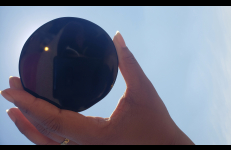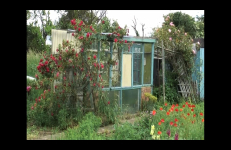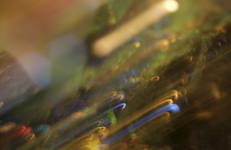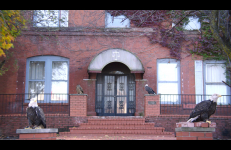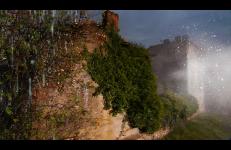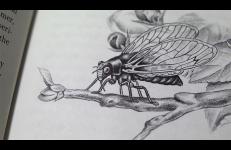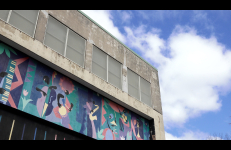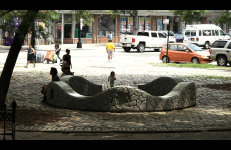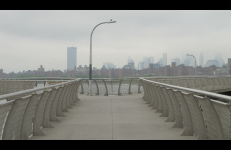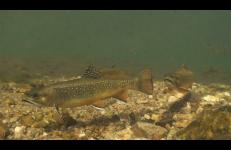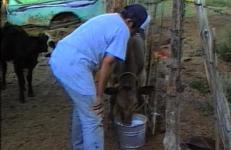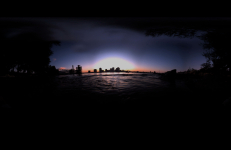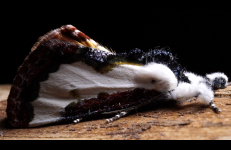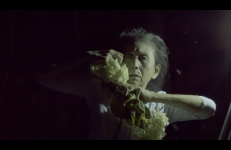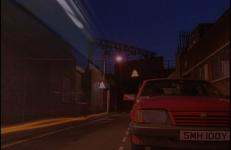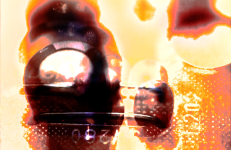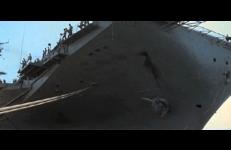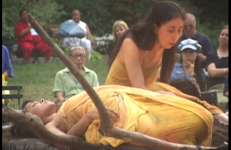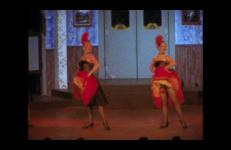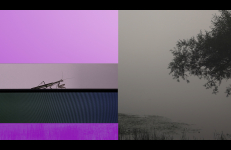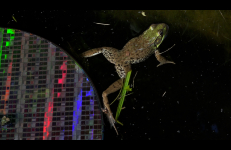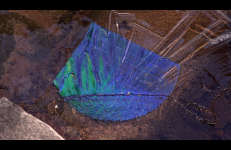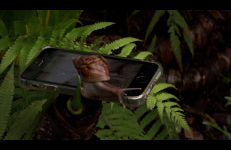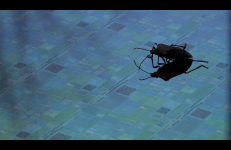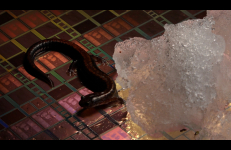A Meditation on Nature in the Absence of an Eclipse is a poetic glimpse into the ways centuries of extraction, racism, pollution, and nature's commodification have altered our relationship to sacred land, water, and resources. A constellation of intersecting histories and source material include testimony from a Water Protector at Standing Rock protesting the Dakota Access Pipeline, contaminated water in Flint Michigan, and original footage of Hierve el Agua near Oaxaca, Mexico, a rock formation revered for its healing properties.
Environment
Memo Mori is a journey through Hackney tracing loss and disappearance. A canoe trip along the canal, the huts of the Manor Garden allotments in Hackney Wick, demolition, relocation, a magical bus tour through the Olympic park and a Hell’s Angel funeral mark a seismic shift in the topography of East London.
This is the clinamen of our times, sparkling bodies into the spiral vortex as well as its chaotic spatial present. Part of the Scattered Geology Audiovisual series.
"I brought live reptiles, birds of prey and exotic flowers to a very stereotyped and neglected section of the city of St. Louis, Missouri which suffers from from severe abandonment and despair, but also has many tranquil vacant lots where nature flourishes. I chose these birds of prey for their symbolic meaning- The bald eagle a symbol of the United States, hawks and owls are messengers. But this is not a film about St. Louis, It's about an anonymous archetype more than a specific locale. St.
An abandoned rural house, the Ravel Quartet in F major and then rain, wind, snow and fog are the elements of which this video is composed. In an impossible procession, one take presents four atmospheric agents to strike against the house. The musical instruments which follow the quartet each become an audio track which corresponds to each one of the atmospheric agents. So the sound of the first violin drips like the rain, that one of the second violin is muffled like the snow, the sound of the viola moves like the wind and that one of the cello vibrates like the fog.
Film time takes on book time. An homage to a Bette J. Davis’ illustrated text, itself an homage to the small music makers of the insect world.
Camera, edit, sound design: Deborah Stratman
Music: Fontanelle
Urban parks consist of two major elements: nature and man-made forms. Parks play an important role in the urban environment, offering relief in everyday life. While parks provide green spaces, they are not natural spaces; they are highly designed. Nature and Geometry in the Park is a series of short videos that explore parks, focusing on form. Case 1 features Herbert Von King Park in the heart of Brooklyn’s Bedford-Stuyvesant neighborhood.
Urban parks consist of two major elements: nature and man-made forms. Parks play an important role in the urban environment, offering relief in everyday life. While parks provide green spaces, they are not natural spaces; they are highly designed. Nature and Geometry in the Park is a series of short videos that explore parks, focusing on form. Case 2 features Fort Greene Park in Downtown Brooklyn, which was originally the site of a fortification built for the Revolutionary War.
Urban parks consist of two major elements: nature and man-made forms. Parks play an important role in the urban environment, offering relief in everyday life. While parks provide green spaces, they are not natural spaces; they are highly designed. Nature and Geometry in the Park is a series of short videos that explore parks, focusing on form. Case 3 features WNYC Transmitter Park, a relatively new park located on the waterfront in Greenpoint, Brooklyn, which opened in 2012.
Nest-Cams features footage from cameras placed in and around nests. Animals showcased include: black-capped chickadee, red squirrel, house wren, horned lark, red-breasted nuthatch, black tern, brook trout, and song sparrow.
Subtitled: The Struggle for Western Shoshone Land Land activists Mary and Carrie Dann confront Federal Bureau of Land Management officers determined to impound the women's livestock until they pay grazing fees on land the Shoshone have never sold or otherwise legally transferred to the U.S. government. Part of an ongoing conflict over who will control ancestral lands in Nevada, this videotape depicts a standoff between the two groups, as activists speak about their ties to the land and their determination to keep it at any cost.
Next Atlantis is a video/sound collaboration between composer Sebastian Currier and filmmaker Pawel Wojtasik. It premiered at Carnegie Hall on January 29th 2010 and had another performance at Philadelphia's Annenberg Center the following night, Jan 30th, 2010. American Composer's Orchestra performed the musical score both nights. In addition to the video images and live orchestra the piece utilizes a surround soundtrack of taped and electronic sounds.
The Night Visitors is a movie about moths. In large and small fragments, looking both inward and out, through a critical lens that is by turns social and personal, the film closely examines these under-known creatures. While The Night Visitors is interested in moths as organisms, with fascinating life histories, staggering biodiversity, and a functional importance as indicators of climate change and habitat degradation, its engagement with them is not primarily entomological.
Collaboration with Joseph Scheer (print making artist specializing in moths) and Rebekkah Palov.
Choreography and editing by Eiko Otake, assisted by Rebekkah Palov.
Eiko is deeply grateful to Institute for Electronic Arts, Alfred University.
Nocturne is a 5-minute film shot entirely at night in deserted streets of London. The film attempts to find images of the city that reveal the presence of the past, or the presence of the dead, hinting at a concealed history. The deserted streets around the east end of London and Docklands reflect an echoic city filled with shadows. Nocturne is composed of long static viewpoints, each shot slowly unfolding in time as though by looking long enough the city's secrets will be revealed.
This is the arche-fossil and the presence of the decay-image rate of his radioactive nucleus as an omen of interesting times. Part of the Scattered Geology Audiovisual series.
The Observers portrays one of the world's last staffed weather observatories in two different seasons. Extreme and unpredictable, the land and sky of Mount Washington, New Hampshire form a varying frame for a climatologist as she goes about the solitary and steadfast work of measuring and recording the weather.
Offering was co-commissioned by Dancing in the Streets (New York), the Walker Art Center (Minneapolis, where the proscenium version premiered January 9, 2003) and the University of Arizona (Tucson).
Offering is a ritual of regeneration after loss. People everywhere have lost ideals and landscapes that were dear to them. Offering was originally developed as a mobile outdoor work. This transportable dance or living site "installation" can be brought into communities to serve a communal need for a ritual of mourning.
The urge to relieve a winter valley of permanent shadow and find fortune in alluvial gravel are part of a long history of desire and extraction in the far Canadian north. Cancan dancers, curlers, ore smelters, former city officials and a curious cliff-side mirrored disc congregate to form a town portrait. Shot on location in Dawson City, Yukon Territory.
Our Non-Understanding of Everything is a series of 16 videos that explore how the structures of architecture, semiconductors, and circuits become forms of expression reflecting hierarchies, cognitive processes, and relationships to the natural environment.
Our Non-Understanding of Everything is a series of 16 videos that explore how the structures of architecture, semiconductors, and circuits become forms of expression reflecting hierarchies, cognitive processes, and relationships to the natural environment.
Our Non-Understanding of Everything is a series of 16 videos that explore how the structures of architecture, semiconductors, and circuits become forms of expression reflecting hierarchies, cognitive processes, and relationships to the natural environment.
Our Non-Understanding of Everything is a series of 16 videos that explore how the structures of architecture, semiconductors, and circuits become forms of expression reflecting hierarchies, cognitive processes, and relationships to the natural environment.
Our Non-Understanding of Everything is a series of 16 videos that explore how the structures of architecture, semiconductors, and circuits become forms of expression reflecting hierarchies, cognitive processes, and relationships to the natural environment.
Our Non-Understanding of Everything is a series of 16 videos that explore how the structures of architecture, semiconductors, and circuits become forms of expression reflecting hierarchies, cognitive processes, and relationships to the natural environment.




